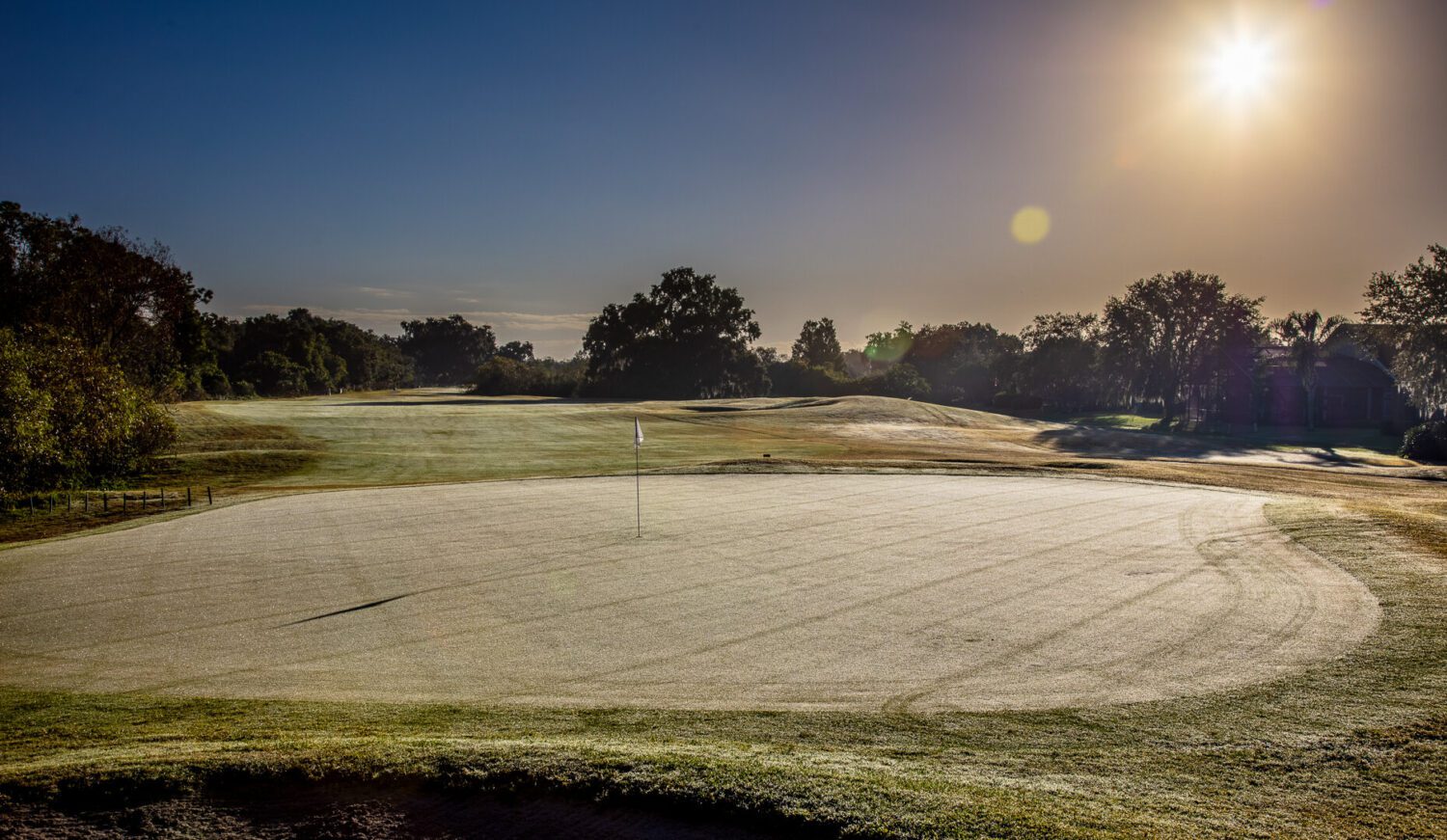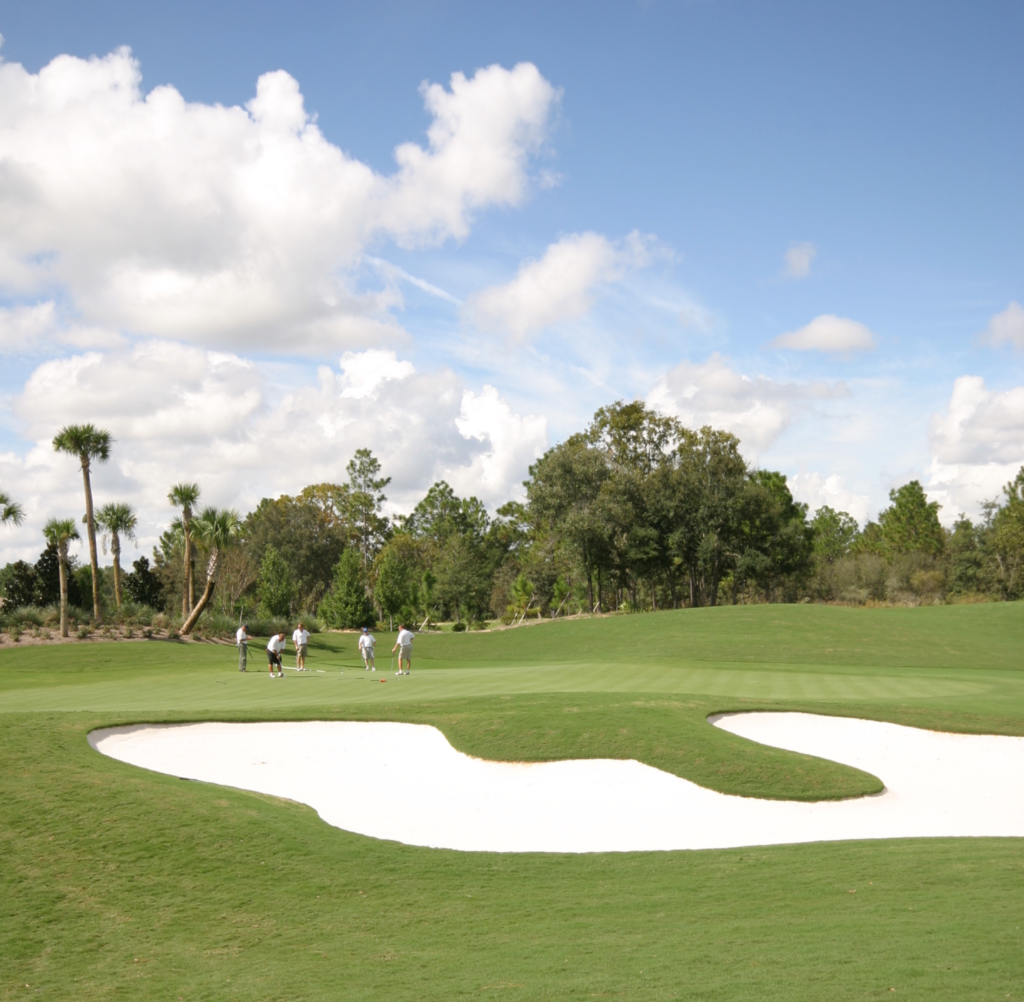A beautifully maintained course at Kissimmee Bay Country Club, Kissimmee, Florida. When it comes to golf courses, it’s a given that the greenest and healthiest grass is always the goal. Unfortunately, keeping a course game-ready isn’t as easy as traditional lawn maintenance.
Since the first golf course was established in 1754, golfers have been finding new ways to maintain and maximize turf health. While there have been many advancements in technology and technique over the years, we still rely on one 18th century practice: topdressing.
Since the advent of golf, topdressing has remained the tried and true method to maintain turf health safely and effectively. While some commercial methods and chemical applications were briefly commonplace, most golf courses have returned to topdressing as the sustainable and trusted alternative.

What Is Topdressing?
Topdressing a golf course is the process of applying a thin layer of sand or sand mixed with organic material to the turf to maintain its quality throughout the year.
Frequent use of a course leads to the accumulation of thatch. Thatch is a loose layer of dead and living shoots or other plant material that forms just below the soil surface. A thatch build-up impacts the firmness of the turf and reduces playability. Topdressing the turf dilutes thatch and keeps the greens smooth, firm and fast.
It is important to remember that topdressing is not an approximate process. It is an exact science. You need to be fully aware of your soil profile to create a topdressing composition that will maintain the pH balance and air porosity of your soil.
Topdressing Techniques
The most common topdressing material used is sand since it is inexpensive. Sand increases the porosity of the turf as sand particles form bridges for air pockets. Some other practices involve creating a mixture of sand, organic matter, and clay.
The type of sand applied during topdressing depends on the turf’s growth rate and the time of the year. Courses with Bermudagrass putting green, for example, require adding more sand during the summer when the grass is actively growing. Putting greens in some areas is topdressed all year. The sand quantity is reduced when soil temperature decreases and turf growth slows. Topdressing of grass areas is usually done with a conditioner at the rate of 500 pounds for every 1000 square feet. To achieve this, many use what is called a hopper-style top dresser to take away most of the labor.
The best topdressing technique is to do it along with the aeration process. This ensures that the topdressing application penetrates into the soil profile, providing more stability rather than being on the surface level. This also makes sure there is no unnecessary sand build-up that will stop the moisture from reaching the roots and impacting their development.
Most topdressing programs involve topdressing the turf at least twice a year. This process is on the heavier side, where the aerated holes are filled with a denser topdressing material. The lighter topdressing is done more frequently (about four to eight times a year) depending on the duration of time when the grass is actively growing.

What Are The Benefits of Topdressing?
When properly applied, regular topdressing can:
Enhance smoothness/fill void between turfgrass leaves and stems within turf canopy
Improve surface resiliency/firmness
Improve drainage due to increased porosity
Improve soil properties to withstand more damage and recover faster
Reduce algae/cushion leaf tips
Increase the quality of the soil, which improves the qualities of grass, density, color, texture, uniformity etc.
Improve soil’s ability to transport water, air and nutrients
Allow better grass growth by stimulating root and shoot growth
Aid decomposition process and naturally supply nutrients to turf
Things to Remember while Topdressing
While topdressing is both an essential and restorative practice, it can quickly go south if improperly approached. Here are some points to keep in mind when you are topdressing your turf.
1.Turf Health:
Make sure your greens are healthy enough to endure the process of aeration and sanding. If they are weak or recovering from a disease, then you need to wait until they are strong enough before you add stress to them.
2. Percentage of Organic Matter:
If you are adding organic matter to your topdressing material, make sure the percentage of organic matter is not too much. Excessive organic matter holds surplus water which makes your greens prone to disease.
3. Quality of the Sand:
All sands are not the same. While a bargain might seem tempting, you need to check the quality of the sand. The particle size of your sand needs to be the right balance between fine and coarse. If your sand is too fine, it will hold excess water and cause water stress. If it is too coarse, it will affect your mower.
4. Grass Type:
Be aware of your grass type before you determine the frequency of your topdressing process. Some grass types require more frequent aeration and topdressing, while other grass might not need it as often.
Consulting a Professional
From the soil mixture to application time and technique, improper or unprofessional topdressing can and will harm your turf health. Not only can excess sand and soil choke your roots, but it can cause poor drainage and nutrient composition, choking your turf and turning your greens to browns.
If you’re thinking of topdressing your golf course and don’t want to risk damagingyour turf in the process, consider hiring a golf course maintenance company like DTE Golf®. We staff fully certified and licensed superintendents, agronomists, and other professionals ready to transform and manage your golf course.

